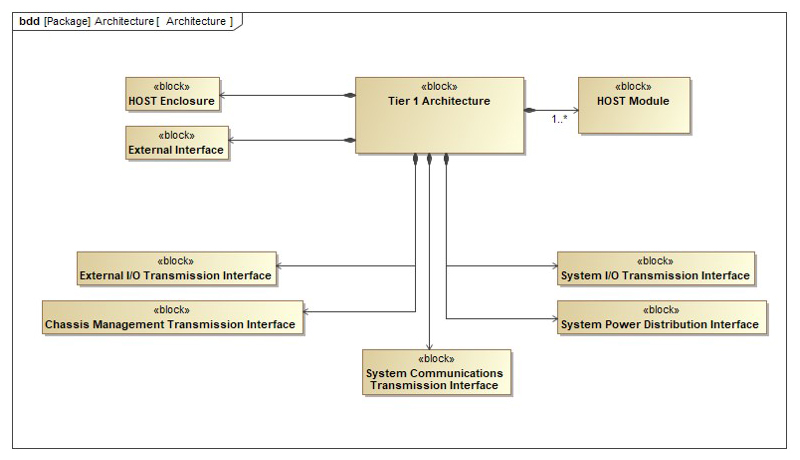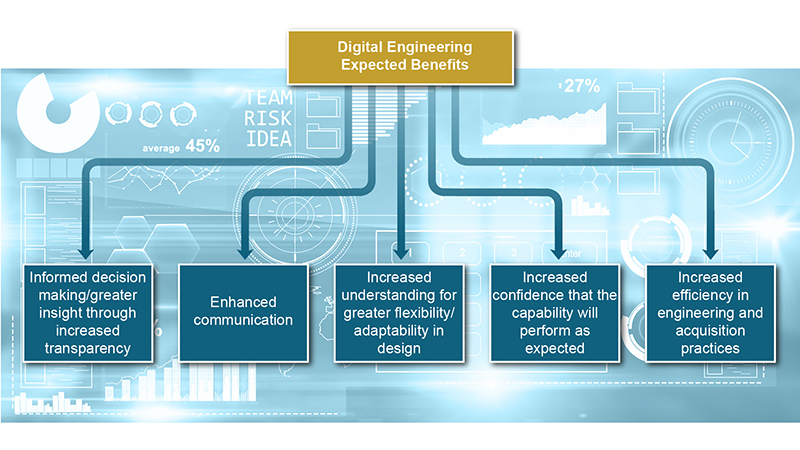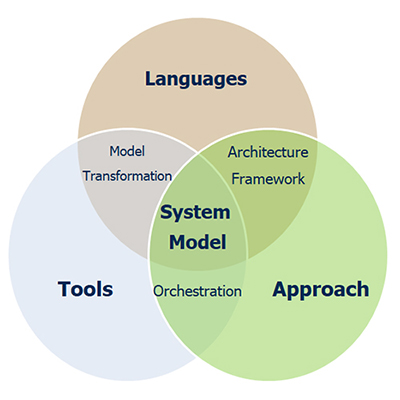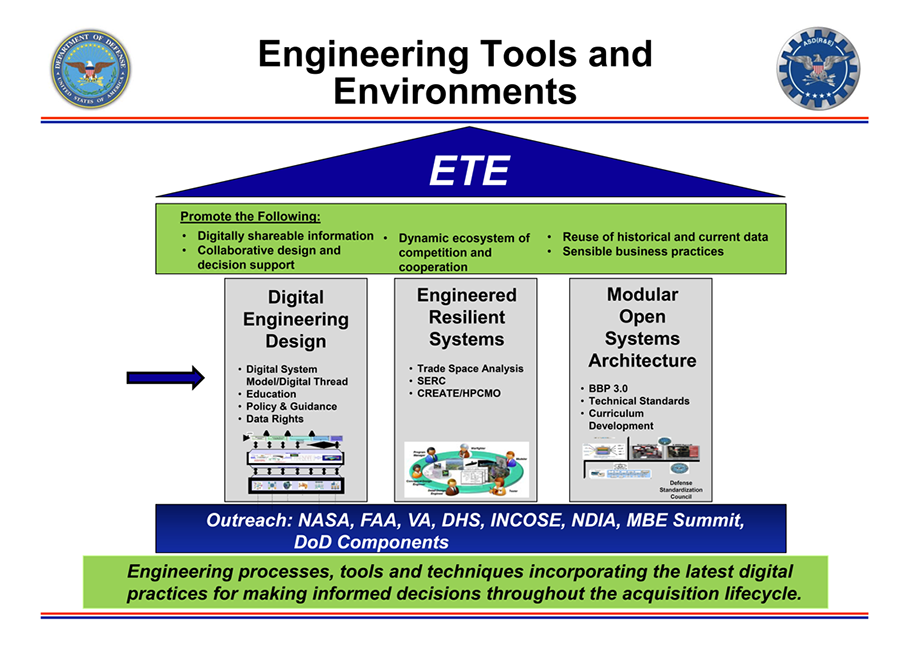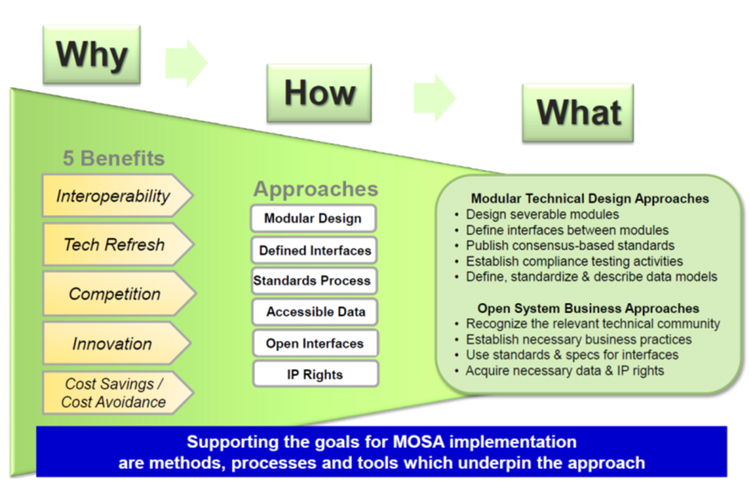The Move to Digital Engineering
To address the need for a more rapid and agile acquisition strategy, the Department of Defense is pursuing a new approach – replacing documents with models in order to shorten acquisition timelines and reduce cost in a digital engineering approach (https://fas.org/man/eprint/digeng-2018.pdf). Digital engineering aims to leverage model-based systems engineering to provide increased transparency, agility, and flexibility to the DoD acquisition process.
Department of Defense Digital Engineering Strategy – June 2018
The MBSE Approach
Model-Based Systems Engineering is defined as “the formalized application of modeling to support system requirements, design, analysis, verification and validation activities beginning in the conceptual design phase and continuing throughout development and later life cycle phases.” (INCOSE SE Vision 2020 – INCOSE-TP-2004-02, Sep 2007)
MBSE is a shift away from a linear, document-centric acquisition process towards a dynamic digital model-centric ecosystem. MBSE is a methodology that focuses on creating and exploiting models as the primary means of information exchange between engineers.
The system models that are created are an integrated representation that covers fundamental aspects of the system architecture and design:
- Structure – parts of the system that are responsible for the behaviors
- Behavior – transformation of inputs to outputs and responses to external stimulus
- Requirements – captures mission operations, stakeholder goals, purposes, and success conditions for the system
- Parametrics – the performance, physical characteristics and governing rules that constrain the structure and behaviors
The figure on the left depicts the three pillars of SysML: Language, Tools, and Approach (Delligatti, Lenny. SysML Distilled a Brief Guide to the Systems Modeling Language. Upper Saddle River, NJ: Addison-Wesley, 2014. Web.) The intersection of all three is the System Model. The System Model is the authoritative, up-to-date source of information at the system level. It is the unified, coherent, and consistent embodiment of the system from which engineering disciplines can view relevant and pertinent information in the form needed to complete engineering design tasks.
Languages – A language in the context of MBSE is simply a standardized medium for the communication of systems engineering concepts and relationships. (Delligatti, Lenny. SysML Distilled a Brief Guide to the Systems Modeling Language. Upper Saddle River, NJ: Addison-Wesley, 2014. Web.) The Systems Modeling Language (SysML) is the de facto modeling language used in MBSE practice however it is not the only language. Other modeling languages such as the Unified Architecture Framework, Unified Modeling Language, MARTE, and SoaML are graphical modeling languages and Modelica is an example of a textual modeling language all of which can be used to express certain aspects of a system design in a particular domain or from a certain life-cycle phase.
Tools – MBSE requires a number of tools to describe, analyze, and manage the system over the design life-cycle. System modeling tools such as Catia/No Magic’s Cameo Systems Modeler, IBM’s Rational Rhapsody, and Sparx’s Enterprise Architect leverage SysML and other UML-based languages to describe the system and in some cases perform behavioral simulation and parametric analysis. (Sanford Friedenthal, Alan Moore, and Rick Steiner. A Practical Guide to SysML, 3rd Edition. Morgan Kaufmann, 2014. Web.) Many of the system modeling tools provide a versioning and collaboration capability to manage changes in the system design over time as well as allow for multiple people to work on the system model at the same time. In addition, many of the system modeling tools provide access to the application program interface for integration with discipline engineering models to perform sophisticated design analyses. Commonalities in domain-specific languages with SysML serving as the semantic foundation and ”lingua franca” can be leveraged to facilitate information exchange between different tools via model-to-model transformations.
Approach – A system development project, like any other, requires a plan, method, or approach. Akin to a road map, “a MBSE approach is a documented set of design tasks that ensures that everyone on the team is building the system model consistently and working toward a common end point.” The MBSE method should align with and implement all or part of the systems engineering process and answer questions such as: who are the stakeholders and what views are necessary to address their concerns, when are key design milestones and reviews and how will they be held, where will the system model be retained, what external tools are needed to perform parametric analyses and trade studies, will the system model be used as an input for downstream design and development teams, and will the model be used to aid in integration and acceptance testing to verify the system after development? (Delligatti, Lenny. SysML Distilled a Brief Guide to the Systems Modeling Language. Upper Saddle River, NJ: Addison-Wesley, 2014. Web.) Orchestration is needed to ensure that information is exchanged between different modeling tools to produce necessary views and conduct analyses across federated modeling tools. Lastly, an architecture framework is used to provide the scaffolding to integrate modeling languages and required views into a consistent and well-formed system model in accordance with the modeling approach.
Why MBSE?
- MBSE: Part of a larger Systems Engineering initiative to incorporate Digital Engineering Design
- Goal: Shift away from a linear, document-centric acquisition process towards a dynamic digital model-centric ecosystem
- Outcome: Documents shift from the primary role of specification to the secondary role of communication
Philomena Zimmerman, Advancing Digital Model-Centric Engineering: Digital System Model/Digital Thread, ODASD(SE), August 17, 2015
Modularity and Open Systems: Meaningful Distinctions – Oct 2015
Model-Based Open Architectures
Open architectures and digital engineering are compatible approaches which share multiple benefits – improved transparency, faster technology cycles, reduced cost. Further, the MBSE approach naturally supports the OA approach by leveraging models to define components of a system and to provide detailed understanding of key interfaces. System models are inherently modular – focusing on defining components of a system and their interfaces to other elements of the system. Leveraging MBSE as the enabling approach to OA paves the way for a process using open standards and commercial-off-the-shelf products for design in a more agile and efficient DoD acquisition process.

